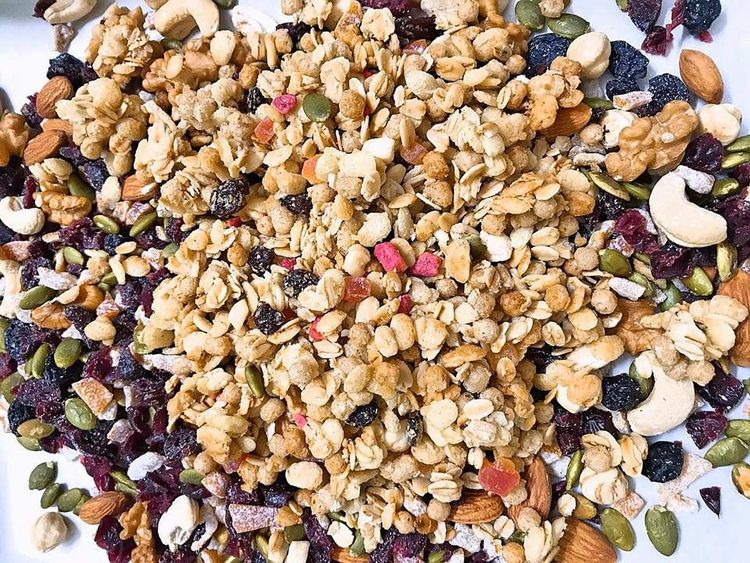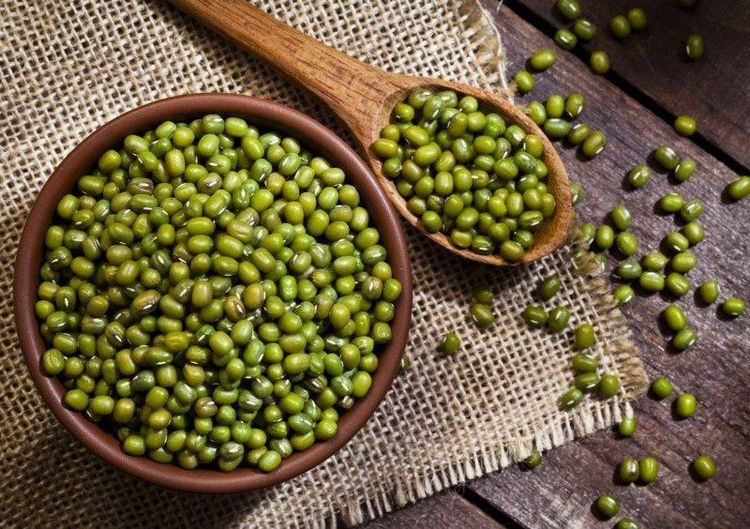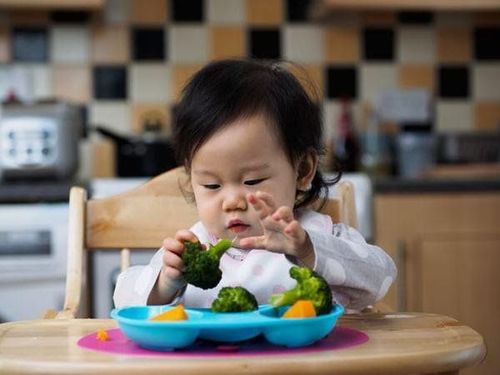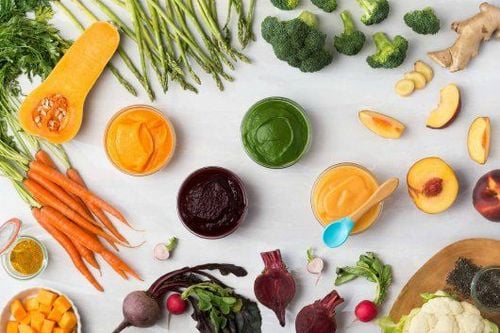This is an automatically translated article.
Providing food and drink for infants from 6-24 months old must have enough energy and enough nutrients suitable for the age and development of the child. By making simple changes to a regular menu, parents can provide delicious meals and snacks that meet the nutritional needs of their children's developmental stages. The following article will provide useful information to help parents and caregivers make early decisions about choosing the right foods and drinks for babies 6 to 24 months old.
1. Signs to start choosing food and drink for children
The American Academy of Pediatrics (AAP) recommends introducing foods or formula when babies are about 6 months old.
Each child is a unique individual, nutritional needs are completely different. Therefore, you can tell your baby is ready for foods other than breast milk or formula through the following signs:
Baby can sit or sit on his own with help from loved ones Child can control Good head control. The baby's head can be steady when placed in a sitting position without tilting The child opens his mouth and leans forward when presented with food. Children control their tongue, can rotate their tongue to bring food from front to back, from left to right and vice versa.

Trẻ có thể sẵn sàng bắt đầu ăn thức ăn khi có thể kiểm soát được lưỡi của mình
2. Principles when choosing foods and drinks for babies to start solids
2.1. What foods to start with?
Reputable nutrition organizations always recommend that for most children, you don't need to give foods in a certain order. Your baby can start eating solid foods at around 6 months old. By the time your baby is 7 or 8 months old, your baby can eat a variety of foods from different food groups. These foods include infant cereals, meat or other proteins, fruits, vegetables, cereals, yogurt and cheeses, and more.
2.2. How to test food allergies in children?
At first, let your child try foods one at a time. This helps you see if your child has any problems with the food, such as a food allergy. Wait 3 to 5 days between each new feed.
Eight foods that cause allergies: Milk, eggs, fish, shellfish, nuts, peanuts, wheat, soy. If your family has a history of allergies to these foods, be cautious when you want to give them to your child or talk to your doctor to get the most helpful advice. Signs of food allergy in children such as: Diarrhea, rash, vomiting.

Trẻ bị tiêu chảy là dấu hiệu của dị ứng thức ăn
2.3. How to prepare baby food?
Currently, there are 3 main schools of weaning: Self-led weaning (BLW); Japanese-style weaning; Traditional weaning. Mothers should consider carefully before choosing the right type of weaning for their children.
Here are some food preparation principles for all 3 methods:
At first, it will be easier for your baby to eat foods that are mashed, pureed, and have a very fine texture. It will take time for your baby to adjust to new food textures. The child may cough, vomit, or spit up. As your baby's chewing skills develop, you can offer your baby solid foods and cubes. Certain foods pose a choking hazard, so it's important to give your child foods that have a growth-appropriate texture. To help prevent choking, prepare foods that can be easily dissolved with saliva and do not require chewing. Offer small portions and encourage your baby to eat slowly. Always watch your child while he or she is eating. Food preparation tips:
Mix cooked cooked cereal with breast milk, formula or water to make it smooth and easy for baby to swallow. Mash or puree vegetables, fruits, and other foods until smooth enough. Hard fruits and vegetables like apples and carrots often need to be cooked so they can be easily mashed or pureed. Cook food until tender enough to mash easily with a fork. Remove all fat, skin, and bones from poultry, meat, and fish before cooking. Remove seeds and pits from the fruit, then cut the fruit into small pieces. Cut soft foods into small pieces or thin slices Cut cylindrical foods such as sausages, hot dogs and cottage cheese into short thin strips instead of round pieces that can get stuck in the airways. Chop up spherical foods like grapes, cherries, berries, and tomatoes. Cook and finely grind or mash whole grains of wheat, barley, rice, and other grains.

Mẹ có thể trộn ngũ cốc cho trẻ ăn kèm
2.4. General recommendations on nutrition in foods and beverages for children
Nutritional foods for children need to be appropriate for their age, in order to:
Provide children with adequate nutrients needed Support for children's comprehensive development Prevent obesity in children.
3. Foods that pose a choking hazard for babies 6 to 24 months old
You can help prevent your child from being in danger of suffocation when eating by:
Only feed your child while sitting. Sit in a high chair or be held by an adult. Avoid eating in a car or trolley. Cook and prepare age-appropriate foods for the child's development. The United States Department of Agriculture's Special Supplemental Nutrition Program for Women, Infants, and Children (WIC) provides a list of foods to avoid because these foods can cause choking in children. 6 to 12 months old and 12 to 24 months old.

Nên để trẻ ngồi khi ăn
3.1. Children from 6 to 12 months old
Babies 6 to 12 months old are learning to chew and swallow food. This is also a time when your child may choke. Pay attention to what your child is eating and what he puts in his mouth. The way food is prepared can increase the risk of choking. Certain foods that are served undercooked, whole, or in certain shapes may present a choking hazard. Cutting food into smaller pieces and grinding food can help prevent choking. Some examples of potential choking hazard foods
Vegetables: Whole grain corn kernels; Uncut cherry or small tomatoes; Whole piece canned fruit; Uncooked dried fruit such as raisins... Grains: Cookies; Potatoes or fried corn; Uncooked whole grains... Sources of protein: Nut butter; Peanut butter; Sausage and meat skewers; Meat has not been stewed; Fish with bones; Large pieces of cheese... Sweets: Hard candies, gum, marshmallows.
3.2. Children 12 - 24 months old
By 12 months, your baby is eating better and can even feed himself. Although your child can now eat most foods, some foods still pose a choking hazard. The way food is prepared can increase the risk of choking. Certain foods that are undercooked, whole or in certain shapes are a major cause of choking. You should still cut food into smaller pieces and grind it to help your child avoid choking. Some examples of potential choking hazard foods:
Vegetables: Unripe carrots; Grapes and cherry tomatoes; Large pieces of raw fruit or vegetable... Grains: Popcorn; French fries... Sources of protein: Whole grain peanuts; Peanut butter; tough meat; Round sausage or sausage slices too big... Sweets: Gum; Hard candy...
4. Specific nutrition of food and drink for babies 6 to 24 months old
4.1. Children 6 - 8 months old
At this age children can eat 4-6 meals a day. If you give your baby formula milk, the average amount of milk per feeding is 180ml - 240ml. But remember not to let children eat more than 950ml/day.
This is also the time to introduce your baby to the recommended foods, but most of the calories he receives are still from breast milk and formula.
At 6 months of age, your baby needs a much higher amount of iron. You need to supplement the baby's weaning diet with iron-rich foods, alternating with maintaining breast-feeding or formula-feeding. Start with baby cereals 2 times a day, a few spoonfuls each time. You can give your baby more solid food and increase the amount when he can control the food in his mouth.
Some foods are rich in iron: green beans, carrots, sweet potatoes, squash, apples, pears, bananas... Some nutrition experts recommend that you start your child's weaning with vegetables first instead of eating them. because of the fruit because the sweetness of the fruit will make the child not like to eat vegetables. The appropriate amount of weaning at this age for fruit is 2 tablespoons and 2 small cups of vegetables per day. How much your child eats will depend on his needs, you should not force him to eat too much of a food that will cause boredom and make him more picky.

Đậu xanh là thực phẩm giàu sắt nên cho trẻ ăn
* Some notes about food in this age:
Never give honey to children under 1 year old. Honey most likely contains bacteria that cause botulism. Do not give cow's milk to babies when they are 1 year old. Use small spoons specifically made for babies. You can give your child a little water to drink between meals or when he wants to. Do not put cereal in baby bottles unless ordered by your doctor. Introduce children to new foods when they are hungry. Do not add salt or sugar to baby food. Foods prepared for baby food should be kept tightly covered in the refrigerator and not more than 2 days.
4.2. Children from 8 - 12 months
At this age, you can offer “finger food” to your child in small amounts. You can tell if your baby is ready by picking up his tip and putting it in his mouth well.
Suitable “finger foods”: Soft cooked vegetables, Washed and peeled fruits cut to taste; Crackers, bread; Pasta... You still continue to feed your baby breast milk or formula 3-4 times a day.
Foods to avoid: Apple peels, apple pieces, fresh grapes, raisins, dry cereals, sliced sausages, peanut butter, popcorn, hard candies, raw vegetables...
You can give them to your child Eat 3-4 egg yolks per week. Many children are allergic to egg whites, so don't give sensitive children egg whites until they are 1 year old. You can add small amounts of cheese, butter, and age-appropriate yogurt.

Có thể cho trẻ tập ăn bánh quy
4.3. 1 year old child
At this age, babies can drink pasteurized whole milk along with breast milk or formula. Many mothers choose to wean their children at this time, but if you don't feel it's really necessary, you don't have to do it right away. Do not give your child low-fat or skim milk because this is the time when your baby needs extra calories from fat for growth and development.
Most of the nutrition your child gets at this age comes from fruits and vegetables, protein, breads and cereals... give your child a variety of foods so they can get the most variety of nutrients. group of nutrients found in food.
Your child starts to stay awake longer, more active. Children can eat less food than before and will also get hungry faster, you should prepare some snacks so that your child can recharge more often.
If your child does not like and is uncooperative when offered new foods. Be patient a few times until the child starts to get used to them. Absolutely do not give children too many sweets and sweet drinks, they make children's teeth very susceptible to decay. At the same time, avoid adding salt, strong spices and products containing caffeine such as tea, coffee, chocolate...

Đồ ăn của trẻ 1 tuổi nên hạn chế ăn muối
4.4. 24 month old baby
After your child is 2 years old, your child's diet should be adjusted to a moderate amount of fat. Diets high in fat can lead to cardiovascular disease, overweight, obesity and physical problems in a child's life. Your child should eat a variety of foods from each food group: breads and cereals, protein, fruits and vegetables, and milk. If your water doesn't have fluoride, it's best to use a toothpaste or mouthwash with added fluoride to protect your child's teeth.
All children need a good source of calcium to develop bones and teeth, but not all children have enough calcium in their bodies. You should provide calcium for children through foods: Dairy products, cooked green vegetables, canned salmon (with mashed bones).
If the child's diet has a variety of groups of substances, it is not necessary for the child to supplement with vitamins, but if the child is too picky, you should take the child to see a nutritionist for helpful advice. useful.
* Tips for dealing with fussy eaters:
Wait a few days before offering food again. It may take more than 10 times before the child can like it. Mix new foods with foods you know your child likes. Create funny or funny pictures of foods on your child's plate. It can help your child get excited about eating it. Try the food first and let your child see you like it. Then let your child try it. Give your child a choice of different foods to try. Let your child decide which one to try today. For children to be healthy and develop well, it is necessary to have a nutritious diet in terms of quantity and quality balance. If children are not provided with adequate and balanced nutrients, it will lead to diseases of excess or lack of nutrients, which adversely affect the comprehensive development of children in terms of physical, mental and motor skills.
The period of baby eating solid foods is an extremely important period to help children develop comprehensively. Children who do not eat properly are at risk of micro-mineral deficiencies, causing anorexia, growth retardation, malabsorption, etc. If they notice the above signs, parents should supplement their children with supportive products. The supplement contains lysine, essential micro-minerals and vitamins such as zinc, chromium, selenium, and B vitamins to help fully meet the nutritional needs of children. At the same time, these essential vitamins also support digestion, enhance nutrient absorption, help improve anorexia, and help children eat well.
Parents can learn more:
Signs of zinc deficiency in children
Micronutrient deficiency and failure to gain weight in children
Please regularly visit Vinmec.com website and update useful information to take care of your child. Take care of the baby and the whole family.
References: cdc.gov













